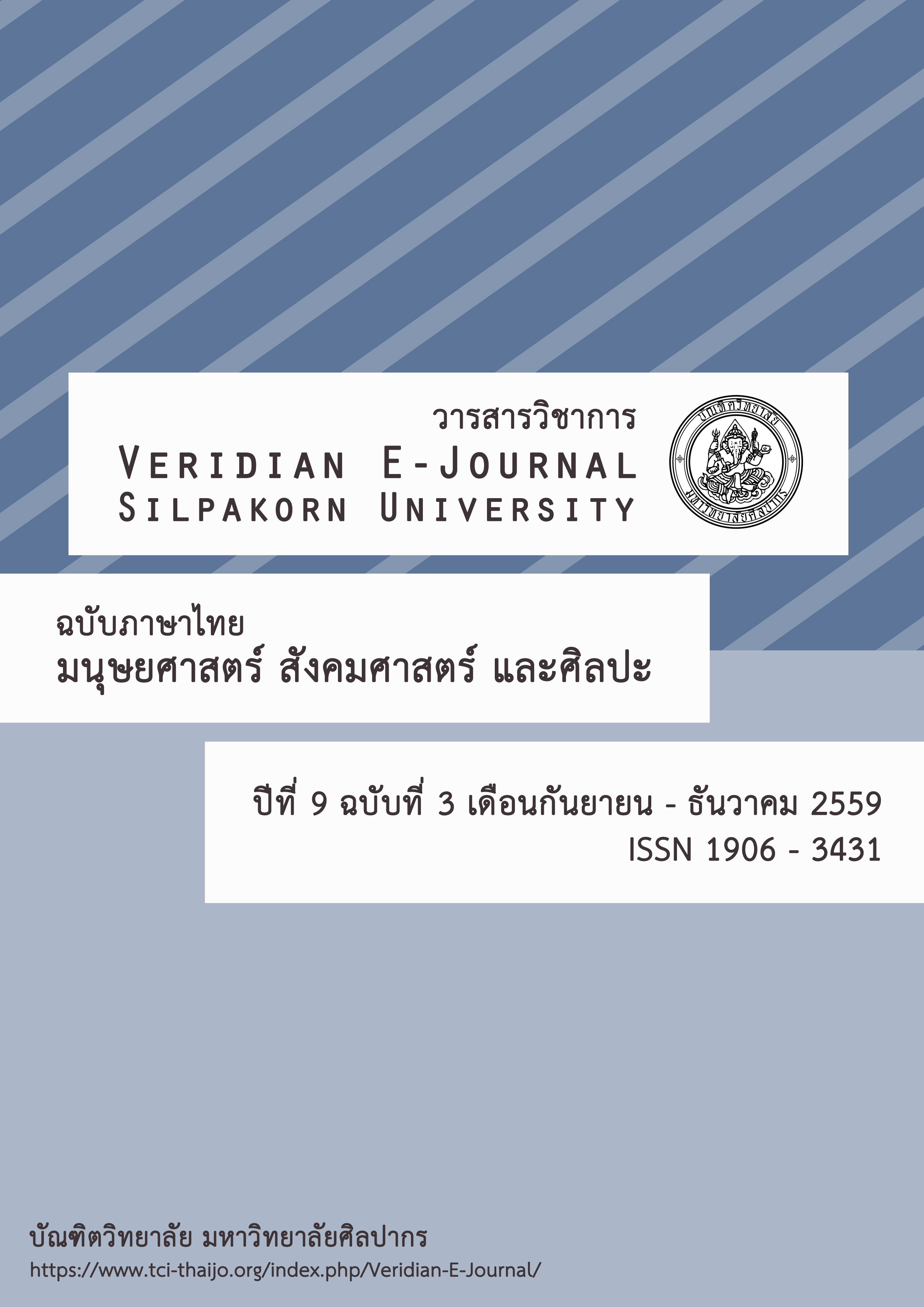การออกแบบบทเรียนอีเลิร์นนิงเพื่อพัฒนาทักษะการคิดขั้นสูงระดับอุดมศึกษา
Main Article Content
Abstract
การวิจัยครั้งนี้มีวัตถุประสงค์เพื่อ 1) ศึกษาความเป็นไปได้และความเหมาะสมในการออกแบบบทเรียนอีเลิร์นนิงแบบใช้กลยุทธ์การสอน 2) เพื่อศึกษาความเป็นไปได้และความเหมาะสมในการออกแบบบทเรียน อีเลิร์นนิงที่จัดสิ่งแวดล้อมการเรียนรู้ตามแนวคอนสตรัคติวิสต์ 3) เพื่อศึกษาความเป็นไปได้และความเหมาะสมในการนำไปใช้พัฒนาทักษะการคิดขั้นสูงระดับอุดมศึกษา กลุ่มตัวอย่างที่ใช้ในการศึกษา ได้แก่ ผู้เชี่ยวชาญ จำนวน 25 คน ด้านเทคโนโลยีและสื่อสารการศึกษา ด้านการออกแบบบทเรียนอีเลิร์นนิง ด้านหลักสูตรและการสอน เครื่องมือที่ใช้ในการเก็บรวบรวมข้อมูล ประกอบด้วย 1) บทเรียนอีเลิร์นนิงที่ออกแบบตามกลยุทธ์การสอน 9 แบบ ได้แก่ บทเรียนอีเลิร์นนิงแบบสร้างความรู้ (PSPSKAPE), แบบบทบาทสมมติ (Role Play) แบบสืบเสาะหาความรู้ (Inquiry based learning), แบบซิปปา (CIPPA Model), แบบร่วมมือกัน (Collaborative Learning), แบบร่วมมือ (Cooperative Learning), แบบโครงงาน (Project based Learning), แบบเรียนรู้ผ่านสถานการณ์ปัญหา (Problem based Learning), แบบใช้กรณีศึกษา (Case based Learning) 2) บทเรียน อีเลิร์นนิงที่จัดสิ่งแวดล้อมการเรียนรู้ตามแนวคอนสตรัคติวิสต์ 2 แบบ ได้แก่ บทเรียนอีเลิร์นนิงแบบเปิด Open Learning Environment (OLEs) และ บทเรียนอีเลิร์นนิงแบบคอนสครัคติวิสต์ Constructivist Learning Environment (CLEs) 3) แบบสอบถามความคิดเห็น การวิเคราะห์ข้อมูลโดยความถี่ ร้อยละ ค่าเฉลี่ยเลขคณิต ( ̅x) และส่วนเบี่ยงเบนมาตรฐาน (S.D.)
ผลการวิจัยพบว่า 1) ภาพรวมการออกแบบบทเรียนอีเลิร์นนิงเพื่อพัฒนาทักษะการคิดขั้นสูงระดับอุดมศึกษาทุกรูปแบบ มีความเป็นไปได้เหมาะสมอยู่ในระดับมากที่สุด ( ̅x=4.69, S.D.= 0.25) 2)ด้านการออกแบบบทเรียนอีเลิร์นนิงแบบใช้กลยุทธ์การสอน มีความเป็นไปได้เหมาะสมอยู่ในระดับมากที่สุด( ̅x= 4.68, S.D.= 0.31) 3) ด้านการออกแบบบทเรียนอีเลิร์นนิงแบบจัดสิ่งแวดล้อมการเรียนรู้ตามแนวคอนสตรัคติวิสต์ มีความเป็นไปได้เหมาะสมอยู่ในระดับมากที่สุด ( ̅x= 4.72, S.D.= 0.38) 4) ด้านการนำไปออกแบบบทเรียนอีเลิร์นนิงแบบกลยุทธ์การสอนกับการจัดสิ่งแวดล้อมการเรียนรู้ตามแนวคอนสตรัคติวิสต์และออกแบบร่วมกันมีความเป็นไปได้เหมาะสมอยู่ในระดับมากที่สุด ( ̅x= 4.73, S.D.= 0.37) 5) ด้านการพัฒนาทักษะการคิดขั้นสูง มีความเป็นไปได้เหมาะสมอยู่ในระดับมากที่สุด ( ̅x= 4.68, S.D.= 0.40) 6) ด้านการนำไปพัฒนาสร้างสื่ออย่างเป็นรูปธรรมและนำไปใช้ให้เกิดการพัฒนาทักษะการคิดขั้นสูงระดับอุดมศึกษาได้อยู่ในระดับมากที่สุด( ̅x= 4.64, S.D.= 0.53)
This research was aimed 1) to study the feasibility and appropriateness of a design on strategic e-learning lesson, 2) to study the feasibility and appropriateness of a design on e-learning lesson with constructivism learning environment, 3) to study the feasibility and appropriateness of e-learning lesson to develop advance thinking skill for undergraduate students. The samples were 25 experts on educational technology and communication, on e-learning lesson design, and on curriculum and instruction. The instruments were 1) e-learning lesson using 9 strategies of learning management; PSPSKAPE, role playing, inquiry learning, CIPPA model, collaborative learning, cooperative learning, project-based learning, problem based learning, case study 2) 2 types of e-learning lesson with constructivism learning environment; open learning environment (OLEs) and constructivist learning environment (CLEs), and 3) questionnaire of opinion. Data was statistically analyzed by frequency, percentage, mean ( ̅x) and standard deviation (S.D.)
The results found that
1) All 9 strategies of learning management used for e-learning lesson design had feasibility and appropriateness at the level of “most” ( ̅x=4.69, S.D.= 0.25)2) The feasibility and appropriateness of a design on strategic e-learning lesson was at the level of “most”( ̅x= 4.68, S.D.= 0.31) 3) The feasibility and appropriateness of a design on e-learning lesson with constructivism learning environment was at the level of “most ( ̅x= 4.72, S.D.= 0.38) 4) The feasibility and appropriateness on application was at the level of “most” ( ̅x= 4.73, S.D.= 0.37) 5) The feasibility and appropriateness on advanced thinking skill was at the level of “most” ( ̅x= 4.68, S.D.= 0.40) 6) The feasibility and appropriateness on application for media creation and advance thinking skill for undergraduate students was at the level of “most” ( ̅x= 4.64, S.D.= 0.53)

